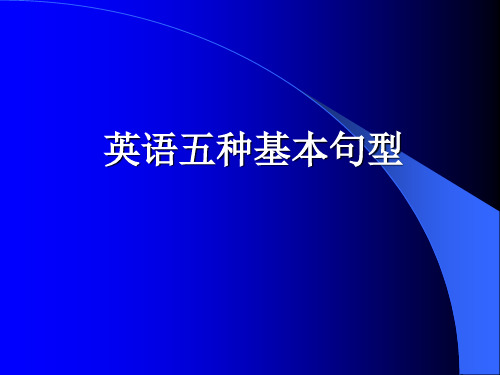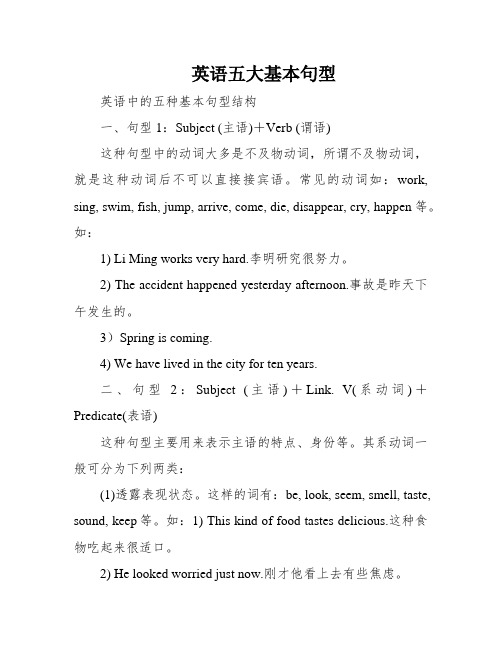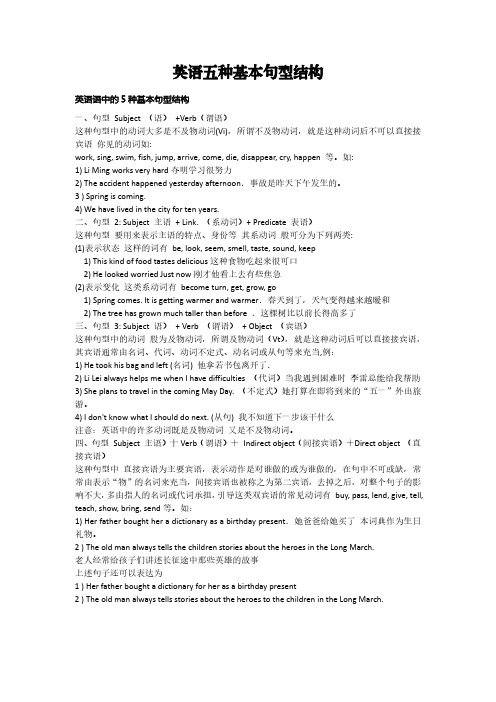英语五大基本句型
英语五种基本句型

Exercise
1. He is studying. 主语 谓语 2. The teachers love us. 主语 谓语 宾语 3. You showed us your photos. 主语 谓语 间宾 直宾 will ask me to jump. 4. Tom will ask me to jump. 主语 谓语 宾语 宾补 5. They can sing well. 主语 谓语 状语
英 语 五 种 基 本 句 型
1. 主语 + 系动词 + 表语 2. 主语 + 谓语 3. 主语 + 谓语 + 宾语 4. 主语 + 谓语 + 间宾 + 直宾 5. 主语 + 谓语 + 宾语 + 宾补
五种基本句型
1. 主语 系动词 表语 (SVC) 主语+系动词 表语: 系动词+表语
He is a student. His face turned red. The apple tastes sweet. The soldier keeps still.
分 析 句 子 结 构
1. His father is a good cook.
主系表
2. She is watering the flowers. 主谓宾 3. You can sing and dance. 主谓 4. We will buy him a book. 5. These books are good. 6. Jack wants me to dance. 7. She has an old car. 8. It’s my duty to help you. 主谓双宾 主系表 主谓宾宾 主谓宾 主系表
英语五种基本句型

for sb)
cook(为某人煮……) cook sb sth (cook sth for sb)
choose(为某人选择……) choose sb sth (choose sth for sb)
make(为某人做……) make sb sth (make sth for sb)
pay(支付给某人……), pay sb sth (pay sth for sb)
buy(为某人买……), buy sb sth (buy sth for sb)
do(为某人做……) do sb sth (do sth for sb) sing(为某人唱……) sing sb sth (sing sth
主语 + 及物动词 + 间接宾语(人) + 直接宾语(物)
1. His father bought him a computer. 2. I sent a birthday gift to her yesterday. 3. My mother taught me how to do it 4. She asked Lucy whose pen it was.
Lucy will make herself known.
I want the work finished soon.
IV. 接现在分词作宾语补足语 的动词常见的有watch, see, hear, find, keep等。如:
birds singing.
I saw the little girl dancing.
V. 接介词短语作宾语补足语的 动词常见的有find, keep, take,consider,等。如:
英语的五大基本句型结构

英语的五大基本句型结构英语的五大基本句型结构一、主语+谓语的句型二、主语+谓语+宾语三、主语+谓语+双宾语(直接宾语+间接宾语)四、主语+谓语+宾语+宾语补足语五、主语+系动词+表语。
及物动词本身需要一个宾语外,还需要一个名词、形容词、副词、动词不定式、分词来补充说明宾语,才能表达一个完整的意念。
1. (主语+谓语)例如:She smiled. (smile是不及物动词vi.,做句子的谓语)在主谓结构中,谓语动词必须是不及物动词(即后面不能接宾语的动词)。
2. (主语+系动词+表语)例如:She is a beautiful girl. (is是be动词,即系动词)在主系表结构中,系动词是判定该结构的重要标志。
英语中常见的连系动词有:(1)be动词(am, is, are, was, were) (2)感官系动词:feel(感觉,感到), smell(闻起来), sound (听起来),taste(尝起来), look (看起来)(3) 变化系动词:become(变成,变得), grow(长成,长得), turn(变成), fall(落下来), get(变得), go(变得), come (来)(4) 状态系动词:seem(看起来,似乎), keep(保持), remain (保持),stay(保持), appear(显得,似乎).3. (主语+谓语+宾语)例如:I like my job. (like是个及物动词vt.,做句子的谓语,后面可以接宾语)4. (主语+谓语+间接宾语+直接宾语)例如:He gave me some books. (give是个及物动词vt.,做句子的谓语,后面可以接双宾语,me是间接宾语,some books是直接宾语,直接宾语指物,间接宾语指人)5. (主语+谓语+宾语+宾语补足语)例如:I found the book interesting. (the book 是句子的宾语,interesting是对宾语the book 的补充说明,即补足语,因为是对宾语的补充说明,所以是宾语补足语。
英语五种基本句型

基本句型 二:S+V+P主+系+表)
1. This │is │what I think. 2. We │felt │delighted. 3. It │proved │right. 4. Our well │has gone │dry.
特点:句子谓语动词都不能表达一个完整的意思, 必须加上一个表明主语身份或状态的表语构成复合 谓语,才能表达完整的意思。这类动词叫做连系动 词。
5. Research has shown us that emotional skills may contribute to some of these qualities, but most of them move far beyond skill-based emotional intelligence. (2021年卷1 D篇阅读改)
Practice makes perfect!
拓展句子: We stopped. We stopped to have a rest. We stopped to have a rest under a tree. We stopped to have a rest under a tree as we were extremely exhausted. On our way home, we stopped to have a rest under a tree as we were extremely exhausted.
3. About 98 cents of every duck stamp dollar goes directly into the Migratory Bird Conservation Fund to purchase wetlands and wildlife habitat for inclusion into the National wildlife Refuge System – a fact that ensures this land will be protected and available for all generations to come. (2021年卷1 C篇阅读)
英语五大基本句型

英语五大基本句型英语中的五种基本句型结构一、句型1:Subject (主语)+Verb (谓语)这种句型中的动词大多是不及物动词,所谓不及物动词,就是这种动词后不可以直接接宾语。
常见的动词如:work, sing, swim, fish, jump, arrive, come, die, disappear, cry, happen等。
如:1) Li Ming works very hard.李明研究很努力。
2) The accident happened yesterday afternoon.事故是昨天下午发生的。
3)Spring is coming.4) We have lived in the city for ten years.二、句型2:Subject (主语)+Link. V(系动词)+Predicate(表语)这种句型主要用来表示主语的特点、身份等。
其系动词一般可分为下列两类:(1)透露表现状态。
这样的词有:be, look, seem, smell, taste, sound, keep等。
如:1) This kind of food tastes delicious.这种食物吃起来很适口。
2) He looked worried just now.刚才他看上去有些焦虑。
(2)透露表现变革。
这类系动词有:become, turn, get, grow, go等。
如:1) Spring comes. It is getting warmer and warmer.春天到了,气候变得越来越和煦。
2) The tree has grown much taller than before.这棵树比从前长得高多了。
三、句型3:Subject(主语)+Verb (谓语)+Object (宾语)这种句型中的动词普通为及物动词,所谓及物动词,就是这种动词后可以直接接宾语,其宾语平日由名词、代词、动词不定式、动名词或从句等来充任。
英语5种基本句型

英语5种基本句型根据英语句子中谓语动词的结构形式变化,这种结构形式的多样性决定了不同谓语动词的特性,由此,我们可以将英语句子划分为五种基本类型,即五种基本句型。
一. Subject (主语) +Verb (谓语)此句型的句子有一个共同特点,即句子的谓语动词都能表达完整的意思。
这种句型中的动词基本上都是不及物动词,这些动词常见的有:appear, apologize,arrive, come, die, disappear, exist, fall, happen, rise,等等,但可以在其后添加修饰成分,如副词,介词短语,甚至状语从句作状语。
如:Time flies.(主语+谓语)The moon rose.月亮升起来了。
(主语+谓语)Birds sing beautifully.(副词)They stayed in a hotel. (介词短语)She apologized to me. 她再次向我道歉。
I had left when they came.(时间状语从句)二.Subject (主语) +Link. V(系动词) +Predicate(表语)此句型的句子有一个共同的特点:句子谓语动词都不能表达一个完整的意思,必须加上一个表明主语身份或状态的表语,才能表达完整的意思。
系动词主要包括:A)be动词。
如am,is are,was,were.如:He is clever.She is a beautiful girl.B)除了be 系动词外,还有一些动词也可以用作系动词,1)表感官的动词。
如:feel, smell, taste, sound, look等。
如:This kind of cloth feels soft.That flower smells good.The food tastes delicious.That piece of music sounds beautiful.He looks ill today.2)表变化和结果的动词。
英语五种基本句型结构

英语五种基本句型结构英语语中的5种基本句型结构一、句型Subject (语)+Verb(谓语)这种句型中的动词大多是不及物动词(Vi),所谓不及物动词,就是这种动词后不可以直接接宾语你见的动词如:work, sing, swim, fish, jump, arrive, come, die, disappear, cry, happen 等。
如:1) Li Ming works very hard夺明学习很努力2) The accident happened yesterday afternoon.事故是昨天下午发生的。
3 ) Spring is coming.4) We have lived in the city for ten years.二、句型2: Subject 主语+ Link. (系动词)+ Predicate 表语)这种句型要用来表示主语的特点、身份等其系动词般可分为下列两类:(1)表示状态这样的词有be, look, seem, smell, taste, sound, keep1) This kind of food tastes delicious这种食物吃起来很可口2) He looked worried Just now刚才他看上去有些焦急(2)表示变化这类系动词有become turn, get, grow, go1) Spring comes. It is getting warmer and warmer.春天到了,天气变得越来越暧和2) The tree has grown much taller than before .这棵树比以前长得高多了三、句型3: Subject 语)+ Verb (谓语)+ Object (宾语)这种句型中的动词股为及物动词,所谓及物动词(Vt),就是这种动词后可以直接接宾语,其宾语通常由名词、代词、动词不定式、动名词或从句等来充当,例:1) He took his bag and left (名词) 他拿若书包离开了.2) Li Lei always helps me when I have difficulties (代词)当我遇到困难时李雷总能给我帮助3) She plans to travel in the coming May Day. (不定式)她打算在即将到来的“五一”外出旅游。
英语简单句中五种基本句型

英语简单句中五种基本句型
英语简单句的五种基本句型是:
1. 主语+谓语(不及物动词):S+V
例如:The sun rises. 太阳升起。
2. 主语+谓语(及物动词)+宾语:S+V+O
例如:I like apples. 我喜欢苹果。
3. 主语+谓语+间接宾语+直接宾语:S+V+IO+DO
例如:He gave me a book. 他给了我一本书。
4. 主语+系动词+表语:S+V+P
例如:She is a doctor. 她是一名医生。
5. 主语+谓语+宾语+宾语补足语:S+V+O+OC
例如:We made him our monitor. 我们选他当班长。
需要注意的是,这些句型只是英语简单句的基本结构,实际应用中还有很多复杂的句型和变化。
同时,英语句子的语序和汉语句子的语序也有所不同,需要在学习中逐渐适应。
英语五大基本句型_

五种基本句型一、主语+谓语(谓语为不及物动词)如:I smiled.He laughed.二、主语+谓语+宾语(谓语为及物动词)如:I like football.I hate selfish people.三、主语+系动词+表语其实这个结构与主谓宾类似,只是一个是实义动词,一个是系动词如:He is a teacher.The flower smells sweet.四、主语+谓语+宾语(somebody)+宾语(something)如:He made me a good man.五、主语+谓语+宾语+宾语补足语这个句型的语后面有两个宾语,这两个宾语放在一起叫双宾语(直接宾语+直接宾语)例如:He made me a cake.Lend me your dictionary, please.这里“me”和“a book”一人一物做宾语就是双宾语这两个宾语:前一个宾语称为"间接宾语",多由代词或名词充当,通常为“人”;后一个宾语称为"直接宾语",往往由名词充当,通常为“物”。
这类句型常有"给某人某物"、"送某人某物"、"留给某人某物"等意思。
常见的这类谓语动词有:give(给某人……),bring(带给某人……), bring somebody somethingtell(告诉某人……), tell somebody somethingsend(送给某人……), send somebody somethingleave(留给某人……), leave somebody somethingpass(递给某人……), pass somebody somethingread(给某人读……), read somebody somethingwrite(给某人写……), write somebody somethingtake(给某人拿……), take somebody somethingshow(给某人看……), show somebody somethingteach(教给某人……), teach somebody somethingget(给某人弄到……), get somebody somethinglend(借给某人……), lend somebody somethingbuy(给某人买……), buy somebody somethingpay(支付给某人……), pay somebody somethinghand(递给某人……) 。
英语中的五种基本句型

英语中的五种基本句型英语句子有长在短,有简有繁,从现象看,似乎千变万化,难以捉摸,但从实质看,可以发现其内在联系,找出其共同规律。
英语句子的基本结构可以归纳成五种基本句型及其扩大、组合、省略或倒装。
掌握这五种基本句型,是掌握各种英语句子结构的基础。
英语五种基本句型列式如下:基本句型一:S +V(主+谓)基本句型二:S +V +P(主+系+表)基本句型三:S +V +O(主+谓+宾)基本句型四:S +V +IO +O(主+谓+间宾+直宾)基本句型五:S +V +O +C(主+谓+宾+宾补)……除了基本句型的成分不变外,通常是在这些成分的前面或后面增加一些修饰语而加以扩大。
这些修饰语可以是单词(主要是形容词、副词和数词),也可以是各种类型的短语(主要是介词短语、不定式短语和分词短语)。
下面以基本句型五(v+o+o.c)为例:We found the hall full.我们发现礼堂坐满了。
We found the great hall full of students and teachers.我们发现大礼堂坐满了学生和教师。
We found the great hall full of students and teacherslistening to an important report.我们发现大礼堂坐满了学生和教师,在听一个重要报告。
We found the great hall full of students and teacherslistening to an important report made by a comrade from the Peopl e's Daily on current affairs in East Europe.我们发现大礼堂坐满了学生和教师,在听人民日报的一位同志作有关东欧局势的重要报告。
……英语中的五种基本句型英语句子有长在短,有简有繁,从现象看,似乎千变万化,难以捉摸,但从实质看,可以发现其内在联系,找出其共同规律。
英语五大基本句型

英语五种基本句型句型一:S+V(主+谓)句型二:S+l i n k-V+P(主+系+表)句型三:S+V+O(主+谓+宾)句型四:S+V+I O+O(主+谓+间宾+直宾)句型五:S+V+O+C(主+谓+宾+宾补)SV(不及物动词)1. Time2. The moon3. The man4. We all5. Everybody6. I7. They8. He9.He10.They flies.rose.cooked.eat, and drink. laughed?woke.talked for half an hour. walked yesterdayis playinghave gone基本句型二S+l i n k-V+P(主+系+表)系动词分两类:(1)表示状态的连系动词。
这些词有:b e,l o o k,s e e m,a p p e a r,s m e l l,t a s t e,s o u n d,k e e p, r e m a i n,等等。
(2)表示转变或结果的系动词。
这些词有:b e c o m e,g e t,g r o w,t u r n,g o,c o m e,p r o v e,等等SLink-V(系动词)P(表语)1. This2. The dinner3. He4. Everything5. He6. The book7. The weather8. His face issmellsfeellooksisisbecameturnedan English dictionary.good.happy.different.tall and strong.interesting.warmer.red.基本句型三S+V+O(主+谓+宾)SV(实义动词)O(宾语)1. Who2. She3. He 8. He 5. They knowslaugh atunderstandsmadeatethe answer?her.English.cakes.some apples.6. Danny7. I4. He likeswantsaidnuts.to have a cup of tea."Good morning."基本句型四S+V+I O+O(主+谓+间宾+直宾)SV(及物)o(多指人)O(多指物)1. She2. She3. He 8. He5. I6. I7. I 4. He passedcookedbroughtboughtshowedgavetoldshowedhimher husbandyouherhimhimmea new dress.a delicious meal.a dictionary.nothing.my pictures.a hand.how to run themachine.that the bus was late.基本句型五S+V+O+C(主+谓+宾+宾补)SV(及物)O(宾语)C(宾补)1. We2. They3. They4. They5. What6. We7. He8. I keeppaintedcallfoundmakessawaskedsawthe tablethe doorsupperthe househimhimmethemclean.green.dinner.dirty.sad?out.to come back soon.getting on the bus.9. I had my hair cut yesterday●练习:判断下面的句子是哪种句型●1.T h e y w o r k h a r d.●2.T h e f l o w e r i s d e a d.●3.P l a n t s n e e d w a t e r.●4.H e g i v e s m e s o m e s e e d s.●5.W e s h o u l d k e e p t h e p l a n t s i n t h e s h a d e.●6.M a n y a n i m a l s l i v e i n t r e e s.●7.Y o u r s i s t e r d a n c e s b e a u t i f u l l y.●8.T h i s f o o d l o o k s i n v i t i n g.●9.T h e y k e p t t h e i r m a r r i a g e a s e c r e t.●10.F o o d k e e p s y o u h e a l t h y.11.T h e p a l a c e s w e r e l a r g e a n d b e a u t i f u l.12.H o r s e-r i d i n g,h a m m e r t h r o w a n d s h o o t i n g a r e s o m e o f t h e m o r e u n u s u a l e v e n t s.13.I w i l l p i c k u p r u b b i s h f r o m t h e g r o u n d.14.Y o u c a n p l a n t a t r e e o r b u i l d a b i r d h o u s e.15.I w i l l t e l l m y f r i e n d s t o p r o t e c t t h e e n v i r o n m e n t.。
英语五种基本句型结构

• 27. collect 28. combat 29.concentrate 30.conduct 31.confirm 32.confront 33.consume34.control 35.convey 38. cut 39. damage 40. debate 41.delay 42.deliver 43.demonstrate 44.deny 45.deserve 46. destroy 47.determine 48.develop 49. discuss
2.双宾语易位时需借助介词for的常用动词
• book sb. sth. = book sth. for sb. 为某人预定某物
• buy sb. sth. = buy sth. for sb. 为某人买某物
• choose sb. sth. = choose sth. for sb. 为某人选某物
The weather suddenly turned much colder. 2)注意turn后接名词作表语不带冠词
turn doctor=become a doctor=make a doctor 成为一名医生
3.1)go作为连系动词,通常与形容词连用,通常表示由好变坏或 由正常情况变成特殊情况。
grow, turn, go变成,成为
1. grow常指逐渐地变成新状态,强调渐变的过程。
grow tall长高;grow louder(声音)大起来 2. 1)turn后面多接表示颜色的形容词作表语,也可以接表示 天气的形容词作表语侧重指变得与原来截然不同。
英语的5大基本句型种类

主语+系动词+表语(简称主系表结构):这种句型中的系动词一般可分为两类,包括表示状态的连系动词和表示转变或结果的系动词。
主语+不及物动词+宾语(简称主谓宾结构):这种句型中的动词不带宾语,通常只表示动作,没有受动者。
主语+及物动词+宾语(简称主谓宾结构):这种句型中的动词带宾语,是及物动词,动作的接受者直接出现在句子中。
主语+动词+双宾语(简称主谓双宾结构):这种句型中的动词可以同时接受两个宾语,一个指人,一个指物。
主语+动词+宾语+宾补(简称主谓宾补结构):这种句型中的动词后面带宾语补足语,用来补充说明宾语的状态或身份。
- 1、下载文档前请自行甄别文档内容的完整性,平台不提供额外的编辑、内容补充、找答案等附加服务。
- 2、"仅部分预览"的文档,不可在线预览部分如存在完整性等问题,可反馈申请退款(可完整预览的文档不适用该条件!)。
- 3、如文档侵犯您的权益,请联系客服反馈,我们会尽快为您处理(人工客服工作时间:9:00-18:30)。
英语中的五种基本句型结构一、句型1: Subject (主语) + Verb (谓语)这种句型中的动词大多是不及物动词,所谓不及物动词,就是这种动词后不可以直接接宾语。
常见的动词如:work, sing, swim, fish, jump, arrive, come, die, disappear, cry, happen等。
如:1) Li Ming works very hard.李明学习很努力。
2) The accident happened yesterday afternoon.事故是昨天下午发生的。
3)Spring is coming.4) We have lived in the city for ten years.二、句型2:Subject (主语) + Link. V(系动词) + Predicate(表语)这种句型主要用来表示主语的特点、身份等。
其系动词一般可分为下列两类:(1)表示状态。
这样的词有:be, look, seem, smell, taste, sound, keep等。
如:1) This kind of food tastes delicious.这种食物吃起来很可口。
2) He looked worried just now.刚才他看上去有些焦急。
(2)表示变化。
这类系动词有:become, turn, get, grow, go等。
如:1) Spring comes. It is getting warmer and warmer.春天到了,天气变得越来越暖和。
2) The tree has grown much taller than before.这棵树比以前长得高多了。
三、句型3:Subject(主语) + Verb (谓语) + Object (宾语)这种句型中的动词一般为及物动词, 所谓及物动词,就是这种动词后可以直接接宾语,其宾语通常由名词、代词、动词不定式、动名词或从句等来充当。
例:1) He took his bag and left.(名词)他拿着书包离开了。
2) Li Lei always helps me when I have difficulties. (代词)当我遇到困难时,李雷总能给我帮助。
3) She plans to travel in the coming May Day.(不定式)她打算在即将到来的“五一”外出旅游。
4) I don’t know what I should do next. (从句)我不知道下一步该干什么。
注意:英语中的许多动词既是及物动词,又是不及物动词。
四、句型4: Subject(主语)+Verb(谓语)+ Indirect object(间接宾语)+Direct object (直接宾语)这种句型中,直接宾语为主要宾语,表示动作是对谁做的或为谁做的,在句中不可或缺,常常由表示“物”的名词来充当;间接宾语也被称之为第二宾语,去掉之后,对整个句子的影响不大,多由指“人”的名词或代词承担。
引导这类双宾语的常见动词有:buy, pass, lend, give, tell, teach, show, bring, send等。
如:1) Her father bought her a dictionary as a birthday present.她爸爸给她买了一本词典作为生日礼物。
2)The old man always tells the children stories about the heroes in the Long March.老人经常给孩子们讲述长征途中那些英雄的故事。
上述句子还可以表达为:1)Her father bought a dictionary for her as a birthday present.2)The old man always tells stories about the heroes to the children in the Long March. 五、句型5: Subject(主语)+Verb (动词)+Object (宾语)+Complement(补语)这种句型中的“宾语+补语”统称为“复合宾语”。
宾语补足语的主要作用或者是补充、说明宾语的特点、身份等;或者表示让宾语去完成的动作等。
担任补语的常常是名词、形容词、副词、介词短语、分词、动词不定式等。
如:1)You should keep the room clean and tidy. 你应该让屋子保持干净整洁。
(形容词)2) We made him our monitor.(名词)我们选他当班长。
3) His father told him not to play in the street.(不定式)他父亲告诉他不要在街上玩。
4)My father likes to watch the boys playing basketball.(现在分词)5) Yesterday I had a picture taken with two Americans.(过去分词)●常见的动词有: tell, ask, advise, help, want, would like, order, force, allow等。
●注意:动词have, make, let, see, hear, notice, feel, watch等后面所接的动词不定式作宾补时,不带to。
如:1) The boss made him do the work all day.老板让他整天做那项工作。
2) I heard her sing in the next room all the time last night.昨天晚上我听见她在隔壁唱了一个晚上。
独立主格结构一)独立主格结构的构成:名词(代词)+现在分词、过去分词;名词(代词)+形容词;名词(代词)+副词;名词(代词)+不定式;名词(代词) +介词短语构成。
二)独立主格结构的特点:1)独立主格结构的逻辑主语与句子的主语不同,它独立存在。
2)名词或代词与后面的分词,形容词,副词,不定式,介词等是主谓关系。
3)独立主格结构一般有逗号与主句分开。
举例:The test finished, we began our holiday.= When the test was finished, we began our holiday.考试结束了,我们开始放假。
The president assassinated, the whole country was in deep sorrow.= After the president was assassinated, the whole country was in deep sorrow.总统被谋杀了,举国上下沉浸在悲哀之中。
Weather permitting, we are going to visit you tomorrow.如果天气允许,我们明天去看你。
This done, we went home.工作完成后,我们才回家。
The meeting gone over, everyone tired to go home earlier.会议结束后,每个人都想早点回家。
He came into the room, his ears red with cold.他回到了房子里,耳朵冻坏了。
He came out of the library, a large book under his arm.他夹着本厚书,走出了图书馆。
三) With的复合结构作独立主格表伴随时,既可用分词的独立结构,也可用with的复合结构。
with +名词(代词)+现在分词/过去分词/形容词/副词/不定式/介词短语举例: He stood there, his hand raised.= He stood there, with his hand raise.典型例题The murder was brought in, with his hands ___ behind his back。
A. being tiedB. having tiedC. to be tiedD. tied答案D. with +名词(代词)+分词+介词短语结构。
当分词表示伴随状况时,其主语常常用with来引导。
由于本句中名词"手"与分词"绑"是被动关系,因此用过去分词,选D.注意:1) 独立主格结构使用介词的问题:当介词是in时,其前后的两个名词均不加任何成分(如物主代词或冠词),也不用复数。
但 with 的复合结构不受此限制A robber burst into the room, knife in hand.( hand前不能加his)。
2) 当表人体部位的词做逻辑主语时,及物动词用现在分词,不及物动词用过去分词。
He lay there, his teeth set, his hand clenched, his eyes looking straight up. 典型例题:Weather___, we'll go out for a walk.A permittedB permittingC permitsD for permitting答案B. 本题中没有连词,它不是复合句,也不是并列句。
句中使用了逗号,且we 小写,可知其不是两个简单句。
能够这样使用的只有独立主格或with的复合结构。
据此判断,本句中使用的是独立结构,其结构为:名词+分词。
由于permit在这里翻译为'天气允许',表主动,应用现在分词,故选B。
如果不会判断独立结构作状语的形式,不妨将句子改为条件句,例如本句改为If weather permits, we'll go out for a walk. 然后将if 去掉,再将谓语动词改为非谓语动词即可。
不能“以貌取意”的常见句型例析1.This is the last thing I would ever want to do.这是我最不愿做的一件事情。
【析】“the last+to do;the last +定语从句”中的last的意思为“leastwilling/likely”,译为“最不愿意;最不可能”。
He's the last man I want to see.他是我最不想见的人。
He is the last person to tell a lie.他是最不可能撒谎的人。
She's the last woman I want to sit next to at dinner.她是我在宴会上最不愿与之挨着坐的女人。
